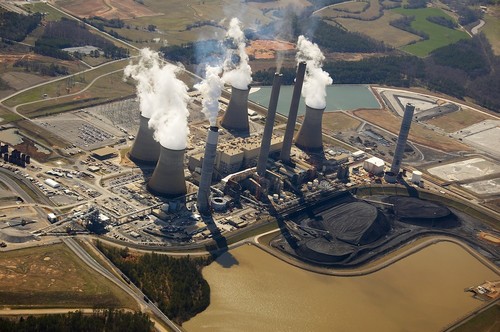 Where will
Georgia Solar Utilities Inc.
get
the 2,200 acres it says it needs to build 80 MW of solar generation?
Well, it’s supposed to be “adjacent to Georgia Power Co’s coal-burning Plant Branch near Milledgeville, Ga.”, so let’s look there.
Where will
Georgia Solar Utilities Inc.
get
the 2,200 acres it says it needs to build 80 MW of solar generation?
Well, it’s supposed to be “adjacent to Georgia Power Co’s coal-burning Plant Branch near Milledgeville, Ga.”, so let’s look there.
 A
brochure on Plant Branch by Georgia Power
(undated, but last date mentioned is 1998, so I’m guessing 1999)
says:
A
brochure on Plant Branch by Georgia Power
(undated, but last date mentioned is 1998, so I’m guessing 1999)
says:
Located on 1,900 acres on Lake Sinclair in Putnam County between
Eatonton and Milledgeville, Plant Branch was the first
million-plus-kilowatt electric generating station to operate on the
Georgia Power system. It is named for Harllee Branch Jr., former
chairman of the board of Southern Company and president of Georgia
Power. Construction on the plant began in 1961, and by the summer of
1969,
 four units were in operation. The 1,539,000 kilowatts
generated by Plant Branch provides enough electrical power for
342,000 households.
four units were in operation. The 1,539,000 kilowatts
generated by Plant Branch provides enough electrical power for
342,000 households.
And now Plant Branch will be among the first to close coal-generating
units.
According to
Melissa Stiers for GPB News 12 July 2011,
Georgia Power Closing Three Plants,
Two coal fired units at Plant Branch in Milledgeville will close in
2013. That’s a result of federal regulation tightening air pollution
controls. The company has said it’s too costly to upgrade those
units.
 As we know, Georgia Power’s parent The Southern Company
claimed it was incompetent to deal with the new EPA regulations
even though it had already announced the Plant Branch closures (amounting to about 770 MW),
and later SO announced
4,000 MW of coal plant closures.
As we know, Georgia Power’s parent The Southern Company
claimed it was incompetent to deal with the new EPA regulations
even though it had already announced the Plant Branch closures (amounting to about 770 MW),
and later SO announced
4,000 MW of coal plant closures.
While the various news stories keep saying Plant Branch is in Milledgeville,
actually, it’s on the other side of Lake Sinclair, closer to Eatonville,
 and in Putnam County.
A quick glance at the
Putnam County Tax Assessor database maps
shows that the land parcel containing Plant Branch
is 913.87 acres, much of which isn’t actually used by the plant.
And Georgia Power owns a total of more than 3,000 acres adjacent
to that site.
So I’m guessing the 2,200 acres figure is simply around 3,100 total
Georgia Power acres minus 913 acres for the present Plant Branch site.
and in Putnam County.
A quick glance at the
Putnam County Tax Assessor database maps
shows that the land parcel containing Plant Branch
is 913.87 acres, much of which isn’t actually used by the plant.
And Georgia Power owns a total of more than 3,000 acres adjacent
to that site.
So I’m guessing the 2,200 acres figure is simply around 3,100 total
Georgia Power acres minus 913 acres for the present Plant Branch site.
Estimates for land needed for a megawatt of solar power generation range
Continue reading →
“We see gas-to-power and wind energy as the ideal mix, together comprising clean and stable energy. Wind energy as the clean energy source, and gas-to-power as the balancing power,” Carsten Krogsgaard Thomsen, DONG Energy’s acting CEO, said.















 for
for 






